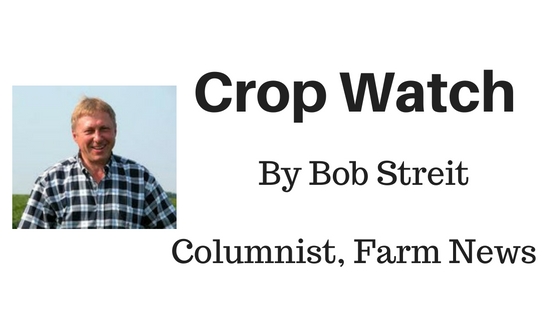
Welcome to 2017 and all that comes with it. January is typically the longest, coldest and darkest month of the year, but we can already notice that the days have begun to lengthen.
Not having snow on the ground helps the temps climb higher each afternoon, so let’s hope that this continues.
Hopefully everyone had a good Christmas season and is ready to get back into the swing of things.
For farmers and livestock operators January is a busy month. There will be lots of educating to be done as well as continuing to make input decisions concerning the 2017 crop. Most operators still have grain marketing to do and grain deliveries to complete.
Variety choices
There are still lots of pieces of performance data to sort through to use in deciding what variety packages to plant in 2017. In the past three or so seasons we have seen the fuller-season hybrids produce more bushels.
Was this a trend, or a function, of farmers planting earlier and being able to capitalize on an excess of growing degree unit accumulation. Will that trend continue or will we see a cooler season arrive? More than one grower has asked what they should do and if they should plant a higher percentage of their acres just south of U.S. Highway 20 to 110 and 112 RM hybrids rather than choosing ones in the 103 to 105 RM range.
The correct answer is typically not in black and white. Instead, a wise choice – and applicable to most areas – would be that the issue of personal drying capacity, expected days require for harvesting all of your acres, past history of stalk diseases and drainage potential in each field in event of a wet spring should all be considered.
An additional factor might be residual phosphorus levels in each field in that the developmental pace of the plants will be partially controlled by the availability of that nutrient. Plants develop faster where P levels are higher.
The latest issue of the International Plant Nutritional Institute spent an entire page on phosphorous. It first discussed how P was vital to energy transfer within the plant once the chlorophyll molecule had captured sunlight energy. P was vital to forming ADP which is then transformed to ATP as the excess energy is transferred around within the cells. Besides being vital to energy transfer it is used to make chromosomal material. If and when low P conditions exist the plants will pull what it needs from stored P amounts which can limit the ability to pull in additional nutrients limiting growth and eventually yields.
On glacial till soils in central and north central Iowa and southern Minnesota, where pH levels are often above 7.4, growers may want to take steps to halt the tie up that can occurs on high pH fields.
Check to see what products work to stop this chelation or check into in-season foliar applications of P.
High residual N levels
After stalk N testing was performed this fall there were growers who found out their stalk N levels were in the “high” to “very high” range, yet their yields didn’t seem to be correlated to those findings. In other words they sometimes found that sidedressing N did not produce any yield increase.
Who or what could give a clue as to what had occurred in the field and what is the course of action to follow next season? This is a great chance to play armchair quarterback.
First of all, the questioner should find out exactly what form of N or compound was tested for and how deep were any cores pulled from. Did the test look at nitrate N, ammonia or ammonium, or organic matter containing nitrogen? Also, did they test down to 30″ or just to 6 or 12 inches?
The cores taken down to 12 inches may only represent 40 percent of what was in the soil. Thus a false low reading may have been generated. The precision N specialists recognize this and are mostly testing deeper than a foot.
Another factor to consider if supplemental N didn’t seem to pay, could relate to zinc, manganese, and boron levels as well as molybdenum.
Shortages in each of the first three and especially the last one can make plants unable to process available nutrients into plant material. In the past year or two more crops people who are being educated on the role of micronutrients are requesting that tissue testing be done to detect such deficiencies.
Remember that one of the major labs in our region is seeing moly being deficient about 95 percent of the time in corn. When we tested soybean leaves in our 2016 tissue testing it was also commonly deficient.
At a cost of about $3 to $4 per acre, correcting the problem is often the cheapest route to follow, especially when buying and sidedressing an additional 40 to 60 pounds of N would cost a lot more and still would not solve the underlying problem.
GMOs at OSU
In an interesting report, there were comparisons made in plot work with Ohio State where conventional hybrids were compared to those carrying above- and/or below-ground insect traits and herbicide traits in 2014 to 2016.
The total bushels produced from each of those groups vary and no data is given as to what insects may have caused problems in those targeted years and if treatment threshold were reached.
They also did not place dollar figures to hybrids that would have varied by more than $200 per bag. I had not seen the results of the trials until now and they had not been publicized much at a time when growers are making crucial decisions.
The data was sorted out in the 2014 through 2016 Ohio Corn Performance Test.
Beans on beans
In today’s situation where more bean acres are being forecast for the coming season we may see growers in fringe areas consider planting soybeans after soybeans.
This is typically not recommended as it is supposed to lower yields. In the Wisconsin Extension newsletter the recommendations are given for those who might be considering the very practice.
They suggested choosing varieties rated good on diseases and switching both maturity and varietal families. Since both BSR and SDS could be a soil borne problem the suggestions could be accurate.
What I have seen in recent years where due to rotations or delayed planting, farmers who were forced to plant second-year beans and observed the rules of being cognizant about disease and SCN ratings produced yields in the high 70s to low 90s.
This should be repeatable in 2017 if the situation demands it. One additional recommendation may be to rotate source of SCN resistance as well.
Banvel-tolerant beans
In an issue that has already gotten a few people killed in the Delta Country, and has been an issue in a few Iowa locations, we will have to see how it is played out in Iowa this year.
We all know that broadleaf weeds are tougher to control because the incidence of tolerance of actual genetic resistance is greater, and their seeds germinate much later than they used to 20 years ago. The rules of when to apply and not apply are more restrictive than any rules before.
Violations and resulting damage is also likely to be more noticeable, and due to today’s economic climate the legal system may come into play quicker. Plus what is also different is that back in the 1996-97 era there were many parties stating that resistance was not going to be generated and the naysayers to this belief were in the minority.
In this case several major companies and university researcher are stating they have already developed resistant strains of weeds in the greenhouse.
In Wisconsin work yield studies show the new beans are 1.8 bpa less than the RR2Y beans.
An added note it that the Texas Wine Growers Association stated its opinion as well as how much the wine-growing business has expanded in their state and it importance to Texas economies. The same could be said for wine and peach growers in many other areas of the country.
We will know in a few years how this might turn out. Until then follow any recommendations as any label specifies and make use of drift retardants if you find yourself needing to use them.
Bob Streit is an independent crop consultant and columnist for Farm News. He can be reached at (515) 709-0143 or www.CentralIowaAg.com.

